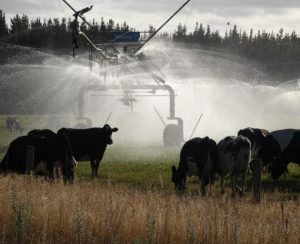
Mr Andrew and his wife Sandra bought and converted the Lumsden-Dipton highway property specifically for once-a-day milking full time, about 10 years ago.
He was born and bred on a Wairarapa sheep and beef farm before moving to Southland to become a rural manager for the Bank of New Zealand.
The Andrews then bought their own farm as part of a syndicate before buying the Dipton property.
He said there was not a lot of difference between the district’s production figures average for twice a day (TAD) milking, and his business’s once-a-day figures.
In addition, he saves about $100,000 in wintering and feed costs and between $60,000 and $70,000 in labour costs annually, by using once-a-day milking full time.
”OAD made economic sense,” Mr Andrew said.
It also significantly reduces his farm’s environmental footprint.
”For us it offers environmental and animal welfare solutions.”
They farm 400ha and lease 100ha from a neighbour and a further 80ha in Waikaka.
They winter 820 cross-bred cows and milk in two herds, with a 270,000kgMS production target.
The cows spend longer in the paddocks and are shifted every 24 hours.
They employ three full time staff members, a part-timer, and he and Mrs Andrew also work on the farm.
”Our costs are so much lower on a per hectare basis, although we have similar net costs,” he said.
He said the cows were healthier, happier, more content and in better condition.
”They are not milking off their backs.
”Cows eat about 30% less [than those on TAD).”
Mr Andrew said dairy farming faced environmental concerns and once-a-day milking was a way to address them.
”Confidence is at rock bottom, and what OAD offers is a real tangible solution to some problems.
”Environmentally, OAD offers a smaller footprint as the cows only come off the paddock once a day.”
That meant half the cattle movements, less effluent on the lanes and in the dairy shed and effluent ponds and less chance of contamination in waterways.
In addition there was less chance of diseases being spread within the herd during milking and members who belong to his OAD discussion group have reported somatic cell counts well below district averages.
Mr Andrew said quality was unaffected and they had consistently been in the top quarter for Open Country Dairy suppliers.
On the other hand, there were some negatives with the system.
Some people experienced a slight drop of about 10% to 15% in production for the first year, and it might take another couple of years to return to previous twice-a-day levels.
”However, if you can’t afford to have production drops, maybe it is not for you.”
He said not all cows were suited to once-a-day milking.
”About 80% of stock will adapt, while about 20% will probably not.
He said the industry did not have a specific breeding programme that focused on OAD genetics.
”If cows are not structurally strong, they are going to break down.
”I have identified cows with strong udders in my herd, which will last longer than TAD cows.”
He said once-a-day systems might not be suitable for sharemilkers.
”Cows are their assets, and valued according to their production, so less production means they are worth less.
”About 10% of national herd is OAD full time.
”OAD has been around for a while and is gaining traction.
”There are quite a few farmers in Southland who milk OAD year round.”
He also advised people considering moving to once-a-day not to ”ramp up stocking rates”.
The discussion closed group has about 30 members but anyone interested in the concept can contact DairyNZ’s Nathan Nelson, on 021 225-6931.























